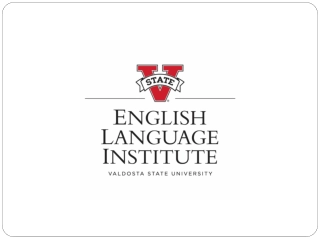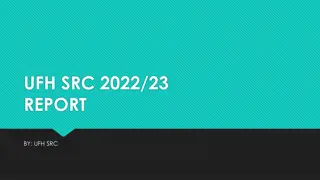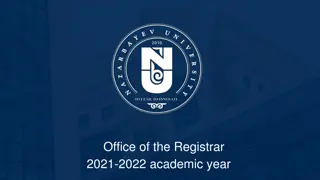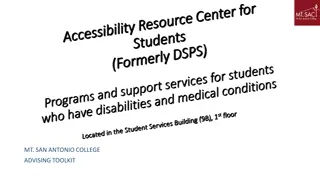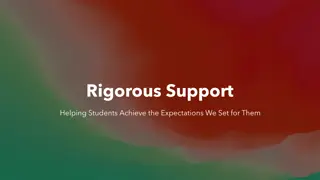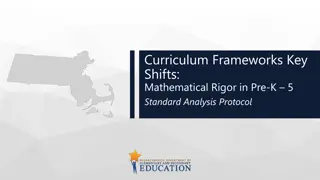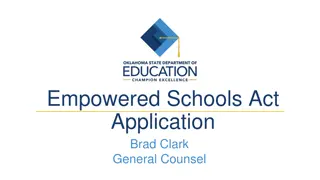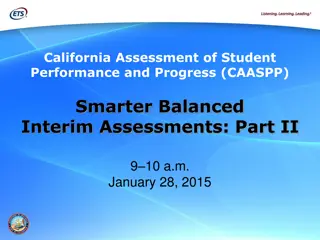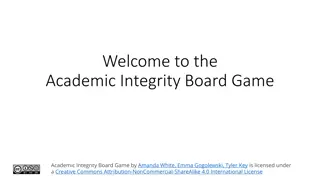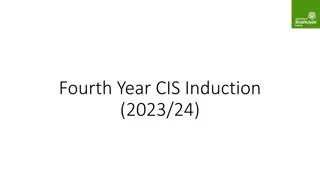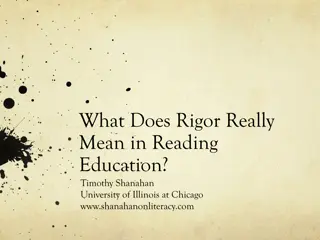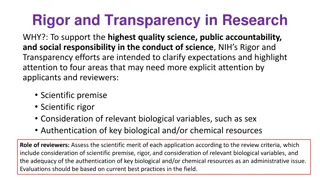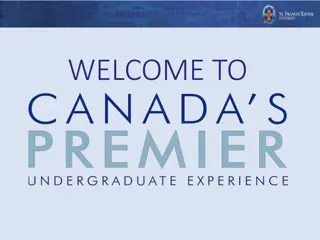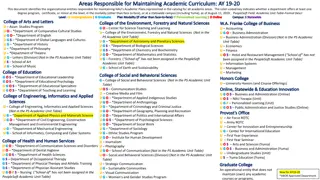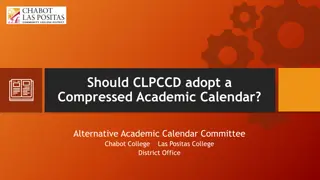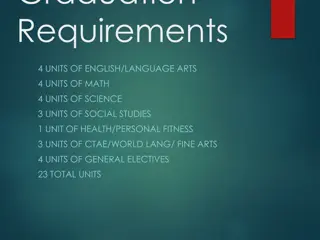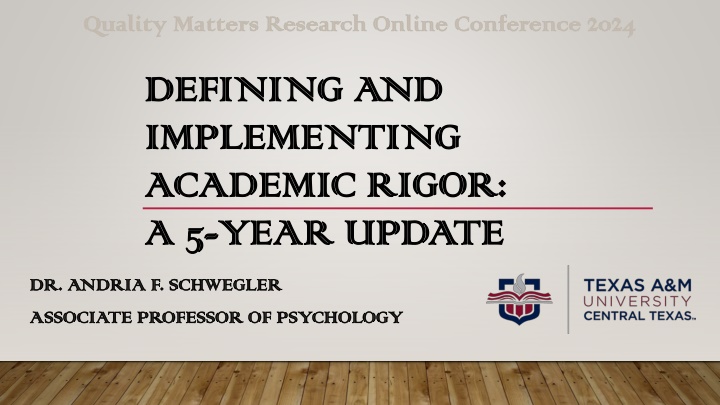
Academic Rigor: Defining and Implementing Strategies for Educational Excellence
Explore the complexities of defining academic rigor in higher education, distinguish its key constructs, and analyze its impact on student learning. Delve into the challenges and responsibilities of both teachers and students in upholding academic standards for continuous improvement.
Download Presentation

Please find below an Image/Link to download the presentation.
The content on the website is provided AS IS for your information and personal use only. It may not be sold, licensed, or shared on other websites without obtaining consent from the author. If you encounter any issues during the download, it is possible that the publisher has removed the file from their server.
You are allowed to download the files provided on this website for personal or commercial use, subject to the condition that they are used lawfully. All files are the property of their respective owners.
The content on the website is provided AS IS for your information and personal use only. It may not be sold, licensed, or shared on other websites without obtaining consent from the author.
E N D
Presentation Transcript
Quality Matters Research Online Conference 2024 Quality Matters Research Online Conference 2024 DEFINING AND DEFINING AND IMPLEMENTING IMPLEMENTING ACADEMIC RIGOR: ACADEMIC RIGOR: A 5 A 5- -YEAR UPDATE YEAR UPDATE DR. ANDRIA F. SCHWEGLER DR. ANDRIA F. SCHWEGLER ASSOCIATE PROFESSOR OF PSYCHOLOGY ASSOCIATE PROFESSOR OF PSYCHOLOGY
Welcoming Newcomers to the Conversation Research Basis Overview A Working Definition of Academic Rigor Location in the Higher Education Landscape AGENDA AGENDA Checking-In on Impact Local Discussions Broader Conversations Applying Concepts for Continuous Improvement Inviting Critical Review and Revision
Define academic rigor. Distinguish among constructs typically confounded with academic rigor. LEARNING LEARNING OUTCOMES OUTCOMES Identify examples of contexts where definition has been applied. Recognize applications at your institution. Critically evaluate definition and suggest research for continuous improvement.
DEFINING ACADEMIC RIGOR DEFINING ACADEMIC RIGOR Academic rigor has a negative connotation (e.g., rigor mortis). Wraga (2010) Academic rigor is widely used but hard to define. Graham & Essex (2001); Draeger et al. (2013) There is no consensus on the definitions of academic rigor that do exist. Hechinger Institute (2009) Academic rigor in higher education is assumed to exist even in the absence of evidence to document it. Labaree (1997); Whitaker (2016)
DEFINING ACADEMIC RIGOR DEFINING ACADEMIC RIGOR Academic rigor as a negotiable standard is a threat to student learning. Schnee (2008) Students reported having weak academic preparation for college. Teachers, with few resources to assist, reported lowering expectations for work. Schutz et al. (2013) 44.5% of faculty members in a community college sample (N = 1,559) reported sometimes assigning grades higher than students actually earned.
DEFINING ACADEMIC RIGOR DEFINING ACADEMIC RIGOR Prior definitions confound teacher responsibilities with student responsibilities. Teachers are responsible for creating conditions to support academic rigor. Students are responsible for learning. Academic rigor is not synonymous with student learning, which is influenced by multiple factors. Prior definitions confound curriculum with course delivery. Curriculum is set collaboratively by program faculty and may include other stakeholders. Pushing higher-level curriculum down to a lower-level course is not academic rigor. Course delivery is determined by individual faculty members. Curriculum and/or student learning can be threatened by lack of implementation fidelity (Mathers et al., 2018, p. 1224)
DEFINING ACADEMIC RIGOR DEFINING ACADEMIC RIGOR Subjective interpretations of effective learning are misleading. Roediger & Karpicke (2006, p. 199) people often do not voluntarily engage in difficult learning activities, even though such activities may improve learning. Kornell & Bjork (2008, p. 591) individuals responsible for the design and evaluation of instruction that involves induction are susceptible to being very misled by their own intuitions and subjective experiences. Kornell & Bjork (2009) Humans fail to predict how much their memory can change over time (i.e., stability bias). Bjork & Bjork (2011) Desirable difficulties facilitate learning.
DEFINING ACADEMIC RIGOR TO DEFINING ACADEMIC RIGOR TO Unconfound Teacher Responsibilities and Student Responsibilities Unconfound Curriculum and Course Delivery Avoid Subjective Interpretations to Reduce Bias via Grounding in Research Be Observable, Measurable, and Subject to Continuous Improvement Prioritize Student Learning
LOCATING ACADEMIC RIGOR LOCATING ACADEMIC RIGOR Used with the permission of Quality Matters
A WORKING DEFINITION A WORKING DEFINITION Academic Rigor is intentionally crafted and sequenced learning activities and interactions that are supported by research and provide students the opportunity to create and demonstrate their own understanding or interpretation of information and support it with evidence. White Paper 1 - Academic rigor: A comprehensive definition. Quality Matters. https://www.qualitymatters.org/index.php/qa-resources/resource-center/articles-resources/academic-rigor-white- paper-part-one
ACADEMIC RIGOR IS Teacher responsibilities are distinct from student responsibilities. A teacher s decisions regarding academic rigor can be observed, measured, and revised for continuous improvement. INTENTIONALLY CRAFTED AND SEQUENCED LEARNING ACTIVITIES AND INTERACTIONS THAT ARE SUPPORTED BY RESEARCH Curriculum is distinct from course delivery. A research basis reduces subjective interpretations and bias and facilitates new advances in SoTL (Hutchings et al., 2011). AND PROVIDE STUDENTS THE OPPORTUNITY TO CREATE AND DEMONSTRATE THEIR OWN UNDERSTANDING OR INTERPRETATION OF INFORMATION Student learning is the purpose of teaching. Students actively construct knowledge, not passively receive it. AND SUPPORT IT WITH EVIDENCE Students justify positions, not merely accept them.
IMPACT: LOCAL DISCUSSIONS IMPACT: LOCAL DISCUSSIONS Institution Level Applications Teaching Philosophies Course Assessment Practices Observations of Teaching
LOCAL DISCUSSIONS LOCAL DISCUSSIONS Teaching Philosophies Idiosyncratic and anecdotal Vs. Scholarly narratives documenting effective teaching practices
LOCAL DISCUSSIONS LOCAL DISCUSSIONS Observation of Faculty Teaching Distinguish teacher responsibilities from student responsibilities (e.g., online, asynchronous course) Excellent Average Good Poor
LOCAL DISCUSSIONS LOCAL DISCUSSIONS Course Learning Assessment Does a graduate course with only multiple-choice exams lack rigor? What research supports this design? Is Roediger & Karpicke s (2006) work on the testing effect sufficient? What evidence are students providing to demonstrate their understanding or interpretation of information? Is I clicked A sufficient evidence?
LOCAL DISCUSSIONS LOCAL DISCUSSIONS Course Learning Assessment Example of a graduate course with evidence of rigor (i.e., intentionally crafted and sequenced learning activities and interactions that are supported by research and provide students the opportunity to create and demonstrate their own understanding or interpretation of information and support it with evidence) Roediger & Karpicke (2006) Testing effect Donovan & Radosevich (1999) Spaced practice Taylor & Rohrer (2010) Interleaving content Kluger & DeNisi (1996) Task feedback Pan & Rickard (2018) Transfer
LOCAL DISCUSSIONS LOCAL DISCUSSIONS Academic Rigor as a Continuum Where do we need to be? What evidence is relevant? What evidence is missing but needed? What is the impact on student learning? Less support for rigor More support for rigor Reframes conversation from personal focus to task focus (i.e., research-based with measurable outcomes; see Kluger & DeNisi, 1996)
IMPACT: BROADER CONVERSATIONS IMPACT: BROADER CONVERSATIONS Conversations at Other Institutions Standards for Graduate Programs Equitable Teaching Universal Design for Learning Characteristics of Good Teaching Institution Accreditation
BROADER CONVERSATIONS BROADER CONVERSATIONS Standards for Graduate Programs Faculty and departments develop new graduate programs in response to scientific, industrial, societal and/or governmental needs. New programs should be rigorous, by which is meant intentionally crafted and sequenced learning activities and interactions that are supported by research and provide students the opportunity to create and demonstrate their own understanding or interpretation of information and support it with evidence and will result in the depth of knowledge outlined above expected of graduate level study upon completion. 2020-2022 Graduate Studies Handbook, University of Arkansas at Pine Bluff
BROADER CONVERSATIONS BROADER CONVERSATIONS Equitable Teaching A caring environment provided for students needs to be associated with supporting students ability to meet high standards instead of lowering academic standards under the mistaken assumption that doing so would be helpful to students (Schwegler, 2019a, p. 9). Artze-Vega, I., Darby, F., Dewsbury, B., & Imad, M. (2023). The Norton guide to equity-minded teaching. W. W. Norton & Company. Free ebook for instructors: https://seagull.wwnorton.com/equityguide
BROADER CONVERSATIONS BROADER CONVERSATIONS Universal Design for Learning It is worth noting that neither Schwegler nor Moore agrees to controlling the ways learners acquire or demonstrate information, in order to be academically rigorous. In other words, the methods and materials should be tools, whose purpose is to support learners to reach the CLRs [course learning requirements] in the most effective ways possible Algonquin College. Universal Design for Learning. https://www.algonquincollege.com/lts/udl/
BROADER CONVERSATIONS BROADER CONVERSATIONS Characteristics of Good Teaching RISE Framework at Lindenwood University: Rigor, Inclusiveness, Support, Engagement Lowered expectations for academic performance have damaging implications because they perpetuate the inequalities students have already experienced when they apply to and enroll in college. Holding some students to lower academic standards because they have insufficient prior preparation fails to close these gaps, and it is a social justice concern because all students are not provided access to a rigorous educational experience (Schwegler, 2019a, p. 9). https://www.lindenwood.edu/human-resources/lindenwood-learning-academy/teaching-and-learning/rise- project/the-rise-guides-definitions-research-and-teaching-resources/
BROADER CONVERSATIONS BROADER CONVERSATIONS Institution Accreditation Northwest Commission on Colleges and Universities https://nwccu.org/accreditation/standards- policies/standards/
APPLYING CONCEPTS FOR APPLYING CONCEPTS FOR CONTINUOUS IMPROVEMENT CONTINUOUS IMPROVEMENT Conversations to be Had; Research to be Performed Student Underutilization of Co-Curricular Support Student - Faculty Behaviors that Impact Learning Faculty Research to Support Teaching and Learning Faculty Uses of Assessment Data Faculty Underutilization of Professional Development Activities
APPLYING CONCEPTS APPLYING CONCEPTS White Paper 2 - Contextualizing academic rigor. Quality Matters. https://www.qualitymatters.org/qa-resources/resource-center/articles-resources/academic-rigorwhite-paper-part-two Student Underutilization of Co-Curricular Support Remedial Coursework Student Support Services
APPLYING CONCEPTS APPLYING CONCEPTS White Paper 3 - Aligning institutional processes to support academic rigor. Quality Matters. https://www.qualitymatters.org/qa-resources/resource-center/articlesresources/academic-rigor-white- paper-part-three Student - Faculty Behaviors that Impact Learning Faculty Research to Support Teaching and Learning Faculty Uses of Assessment Data Faculty Underutilization of Professional Development Activities
APPLYING CONCEPTS APPLYING CONCEPTS How might you apply the definition of academic rigor or related concepts at your institution? Please add ideas in the chat!
INVITING CRITICAL REVIEW INVITING CRITICAL REVIEW
CRITICAL REVIEW CRITICAL REVIEW Clark & Talbert (2021). Rigor. Grading for Growth. https://gradingforgrowth.com/p/rigor There s a lot going on there. Don t use rigor at all. Key Pillars of Grading Systems Clearly defined standards with marks that indicate progress Helpful feedback and reattempts without penalty
CRITICAL REVIEW CRITICAL REVIEW Elkhoury, Ali, & Sutherland-Harris (2023). Exploring faculty mindsets in equity- oriented assessment. Journal of University Teaching & Learning Practice, 20(5). https://doi.org/10.53761/ 1.20.5.12 Academic challenge that supports learning and growth in students made more effective by an equity-informed approach that takes student diversity seriously This definition aligns with, but is more open-ended, than that of Schwegler . Equity-informed assessment practices can in fact enhance academic rigor by ensuring alignment with learning outcomes and assessment reliability
CRITICAL REVIEW AND REVISION CRITICAL REVIEW AND REVISION Make it better! Apply concepts in the Rigor White Papers Determine the limits Empirically test the techniques Revise the definition and context Share the results so we all learn https://commons.wikimedia.org/wiki/File:Scientific_Method_3.jpg
CRITICAL REVIEW AND REVISION CRITICAL REVIEW AND REVISION What are the shortcomings? How can we improve these ideas for the benefit of student learning? Please add ideas in the chat or email me!
Thank you for attending! Thank you for attending! DEFINING AND IMPLEMENTING DEFINING AND IMPLEMENTING ACADEMIC RIGOR: ACADEMIC RIGOR: A 5 A 5- -YEAR UPDATE YEAR UPDATE DR. ANDRIA F. SCHWEGLER DR. ANDRIA F. SCHWEGLER SCHWEGLER@TAMUCT.EDU SCHWEGLER@TAMUCT.EDU
REFERENCES REFERENCES Bjork, E. L., & Bjork, R. A. (2011). Making things hard on yourself, but in a good way: Creating desirable difficulties to enhance learning. In M. A. Gernsbacher, R. W. Pew, L. M. Hough, & J. R. Pomerantz (Eds.) Psychology and the real world: Essays illustrating fundamental contributions to society (pp. 56- 64). New York, NY: Worth. Donovan, J. J., & Radosevich, D. J. (1999). A meta-analytic review of the distribution of practice effect: Now you see it, now you don t. Journal of Applied Psychology, 84(5), 795-805. Draeger, J., del Prado Hill P., Hunter, L. R., & Mahler, R. (2013). The anatomy of academic rigor: The story of one institutional journey. Innovative Higher Education, 38, 267-279. Graham, C., & Essex, C. (2001). Defining and ensuring academic rigor in online and on-campus courses: Instructor perspectives. Annual Proceedings National Convention of the Association for Educational Communications and Technology, 1-2, 330-337. Hechinger Institute. (2009). Understanding and reporting on academic rigor. Retrieved from http://hechinger.tc.columbia.edu/primers/Hechinger_Institute_Rigor_Primer.pdf Kornell, N., & Bjork, R. A. (2008). Learning concepts and categories: Is spacing the enemy of induction ? Psychological Science, 19(6), 585-592. Kornell, N., & Bjork, R. A. (2009). A stability bias in human memory: Overestimating remembering and underestimating learning. Journal of Experiemental Psychology: General, 138(4), 449-468.
REFERENCES REFERENCES Kluger, A. N., & DeNisi, A. (1996). The effects of feedback interventions on performance: A historical review, a meta-analysis, and a preliminary feedback intervention theory. Psychological Bulletin, 119(2), 254-284. Labaree, D. F. (1997). Public goods, private goods: The American struggle over educational goals. American Educational Research Journal, 34(1), 39-81. Mathers, C. E., Finney, S. J., & Hathcoat, J. D. (2018). Student learning in higher education: A longitudinal analysis and faculty discussion. Assessment & Evaluation in Higher Education, 43(8), 1211-1227. Pan, S. C., & Rickard, T. C. (2018). Transfer of test-enhanced learning: Meta-analytic review and synthesis. Psychological Bulletin, 144(7), 710-756. doi: 10.1037/bul0000151 Roediger, H. L., & Karpicke, J. D. (2006). The power of testing memory: Basic research and implications for educational practice. Perspectives on Psychological Science, 1, 181-210. doi: 10.1111/j.1745-6916.2006.00012.x Schnee, E. (2008). In the real world no one drops their standards for you : Academic rigor in a college worker education program. Equity & Excellence in Education, 41(1), 62-80. doi: 10.1080/10665680701764502 Schutz, K. R., Drake, B. M., & Lessner, J. (2013). Do community college full-time and adjunct faculties differ in their perceptions of rigor in assigning grades? American Journal of Educational Studies, 6(2), 59-77.
REFERENCES REFERENCES Schwegler, A. F. (2019a). Academic rigor: A comprehensive definition. Quality Matters. https://www.qualitymatters.org/qa-resources/resource- center/articles-resources/academic-rigor-white-paper-part-one Schwegler, A. F. (2019b). Contextualizing academic rigor. Quality Matters. https://www.qualitymatters.org/index.php/qa-resources/resource- center/articles-resources/academic-rigor-white-paper-part-two Schwegler, A. F. (2019c). Aligning institutional processes to support academic rigor. Quality Matters. https://www.qualitymatters.org/index.php/qa- resources/resource-center/articles-resources/academic-rigor-white-paper-part-three Taylor, K., & Rohrer, D. (2010). The effects of interleaved practice. Applied Cognitive Psychology, 24, 837-848. Whitaker, M. (2016). (Re)defining academic rigor: From theory to praxis in college classrooms. Currents in Teaching & Learning, 8(1), 4-17. Wraga, W. G. (2010). What s the problem with a rigorous academic curriculum ? Paper presented at the meeting of the Society of Professors of Education/American Educational Research Association, Denver, Colorado. Retrieved from https://eric.ed.gov/?id=ED509394

